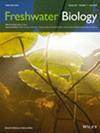鱼、光和外来溶解有机碳对绿色和棕色食物网相互作用的联合影响:水生中生态实验
IF 2.7
2区 生物学
Q2 ECOLOGY
引用次数: 0
摘要
绿色食物网和棕色食物网之间的相互作用挑战了生态系统中自上而下和自下而上级联效应的经典概念。绿色食物网依靠光合作用,棕色食物网依靠死有机物的矿化。这两种食物网之间的相互作用对生态系统的功能至关重要,因为有机碳的主要部分是由绿色食物网产生的,而矿物质营养物质主要是通过棕色食物网回收的。然而,如果分解者的营养有限,绿色和棕色食物网可以争夺矿物质营养。因此,对一个食物网自下而上或自上而下的影响可能对另一个食物网产生重大的级联效应。在淡水中生态系统实验中,我们测试了以阳光过滤为目标的绿色食物网和以有机碳添加为目标的棕色食物网的级联自下而上效应;由鱼类存在介导的自上而下的级联效应。我们的主要发现是,在日光减少的中生态系统中,鱼类对浮游植物密度有积极影响。鱼类对褐色食物网也有积极的影响,增加了异养原核生物和微生物真核生物的丰度。但对浮游动物生物量无显著影响。我们没有观察到光处理对棕色食物网和有机碳处理对绿色食物网的级联效应。我们的有机碳处理对棕色食物网几乎没有影响。对观察到的鱼和光相互作用最可能的解释是,在鱼存在的情况下,泥沙产量和DOC积累增加,体现了一种由营养循环介导的自下而上效应。我们的有机碳处理缺乏效果可能是由于添加的碳量适中和一些添加的分子的生物利用度低。我们的实验表明,鱼类可以通过营养循环的自下而上效应强烈刺激浮游植物,而不仅仅是通过自上而下控制大型食草浮游动物的经典营养级联效应。本文章由计算机程序翻译,如有差异,请以英文原文为准。
Combined Effects of Fish, Light and Allochthonous Dissolved Organic Carbon on Interactions Between Green and Brown Food Webs: An Aquatic Mesocosm Experiment
- The classical concepts of top-down and bottom-up cascading effects in ecosystems are challenged by the interactions between green and brown food webs. The green food web relies on photosynthesis and the brown food web relies on the mineralisation of dead organic matter. Mutualistic interactions between these two food webs are crucial for ecosystem functioning because a major fraction of organic carbon is produced by the green food web, while mineral nutrients are mainly recycled through the brown one. However, green and brown food webs can compete for mineral nutrients if decomposers are nutrient limited. Thus, bottom-up or top-down effects on one food web can have major cascading effects on the other one.
- In our freshwater mesocosm experiment, we tested cascading bottom-up effects targeting the green food web through sunlight filtering and the brown food web through organic carbon addition; cascading top-down effects mediated by fish presence.
- Our main finding is a positive effect of fish on phytoplankton density in mesocosms where daylight was reduced. Fish also had a positive effect on the brown food web with increased abundances of heterotrophic prokaryotes and microbial eukaryotes. However, they had no significant effect on zooplankton biomass. We did not observe any cascading effect of light treatment on the brown food web and of organic carbon treatment on the green food web. Our organic carbon treatment had nearly no effect on the brown food web.
- The most likely explanation for the observed fish × light interaction is a bottom-up effect mediated by nutrient cycling embodied by the increased sediment production and DOC accumulation in the presence of fish. The lack of effect of our organic carbon treatment may be due to the moderate quantity of added carbon and of the low bioavailability of some of the added molecules.
- Our experiment suggests that fish can strongly stimulate phytoplankton through bottom-up effects due to nutrient cycling, and not only through the classic trophic cascade due to the top-down control on large herbivorous zooplankton.
求助全文
通过发布文献求助,成功后即可免费获取论文全文。
去求助
来源期刊

Freshwater Biology
生物-海洋与淡水生物学
CiteScore
5.90
自引率
3.70%
发文量
162
审稿时长
2 months
期刊介绍:
Freshwater Biology publishes papers on all aspects of the ecology of inland waters, including rivers and lakes, ground waters, flood plains and other freshwater wetlands. We include studies of micro-organisms, algae, macrophytes, invertebrates, fish and other vertebrates, as well as those concerning whole systems and related physical and chemical aspects of the environment, provided that they have clear biological relevance.
Studies may focus at any level in the ecological hierarchy from physiological ecology and animal behaviour, through population dynamics and evolutionary genetics, to community interactions, biogeography and ecosystem functioning. They may also be at any scale: from microhabitat to landscape, and continental to global. Preference is given to research, whether meta-analytical, experimental, theoretical or descriptive, highlighting causal (ecological) mechanisms from which clearly stated hypotheses are derived. Manuscripts with an experimental or conceptual flavour are particularly welcome, as are those or which integrate laboratory and field work, and studies from less well researched areas of the world. Priority is given to submissions that are likely to interest a wide range of readers.
We encourage submission of papers well grounded in ecological theory that deal with issues related to the conservation and management of inland waters. Papers interpreting fundamental research in a way that makes clear its applied, strategic or socio-economic relevance are also welcome.
Review articles (FRESHWATER BIOLOGY REVIEWS) and discussion papers (OPINION) are also invited: these enable authors to publish high-quality material outside the constraints of standard research papers.
 求助内容:
求助内容: 应助结果提醒方式:
应助结果提醒方式:


